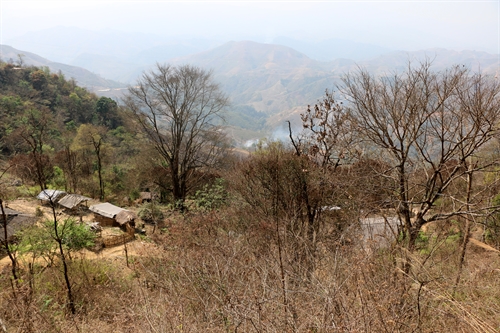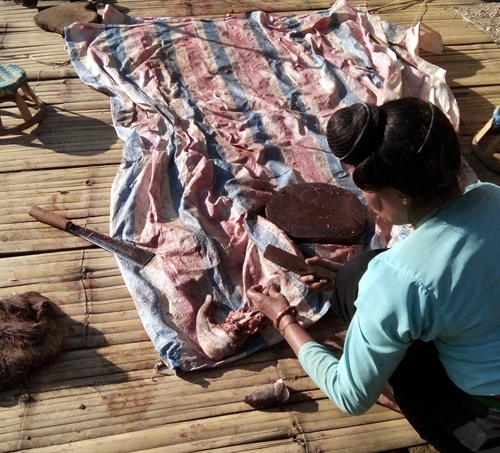 Sunday/Weekend
Sunday/Weekend

Việt Nam News reporters traveled to Điện Biên Province last week to investigate how villagers are coping after a cold snap in January killed hundreds of buffaloes and ruined forest land and vegetation. The reporters spoke to a dozen villagers in the province’s Điện Biên Đông District.
 |
| Harsh winter: On the way to Phì Nhừ Commune in Điện Biên Đông District, only dead forests were visible. About 2,500ha of forest in many communes have been severely damaged by frost. — VNS Photo Đoàn Tùng |
By Bảo Hoa
ĐIỆN BIÊN (VIỆT NAM NEWS) — Lò Văn Lún’s family, who lives in a poor household in the district, relies on their buffaloes and agricultural work to keep food on the table. Yet they lost two buffaloes to a cold snap in January that killed hundreds of cattle and damaged wide areas of forest, leaving the district’s villagers and authorities much to worry about as they start early preparations for next winter.
“We had three buffaloes - lost two,” Lún said. “One of them was a year old. The other was three.”
Temperatures fell below 0 degrees Celsius in several areas of the district from January 23-28. A total of 358 cattle succumbed to the cold and died, affecting agricultural production and the livelihoods of hundreds of households.
“There are nine members in our family. There were months during which we ate young bamboo and cassava instead of rice, despite the work we put into our paddy field,” Lún said. “Losing two buffaloes is such a huge loss for us.”
As a male buffalo costs from VNĐ50 to 60 million (US$2,243 to 2,691) and a mature cow costs from VNĐ30 to 40 million ($1,345 to 1,794), a cattle means a fortune to Mông ethnic minority households, according to Vũ Ngọc Hoành, head of the district’s agricultural division.
“Losing a buffalo is like having their major source of wealth cut off,” he said. “A woman in Na Son Commune could not stop crying while cooking the meat of her dead buffalo.”
Lò Văn Túng, another villager who also lost two buffaloes, is worried about how he would continue his agricultural production.
“We have a big paddy field of 3,000sq.m and four buffaloes,” he said. “Now that two of them have died, the remaining two are overloaded with work because they must plow and turn soil for the whole field.”
More than 7,600 cattle died in the northern and central provinces due to the cold snap by the end of January 27, according to the agricultural ministry.
Điện Biên Đông District saw the highest number of dead cattle in Điện Biên Province. The most affected communes were Phì Nhừ (61 deaths), Keo Lôm (46), Na Son (43), Pu Nhi (37) and Xa Dung (37), according to the district’s report.
Hoành said there were two main reasons for the cattle’s deaths.
“As it has been a custom for the ethnic villagers to let their cattle live in the forest, they leave them there even during cold periods,” he said.
“Despite our advice to return the cattle home early and use different techniques to prevent them from getting sick, villagers continued their practices until the weather got really cold,” Hoành said. “At that point, the cattle’s immune systems had already been weakened, so it was difficult for them to survive.”
The division had sent official documents to the province’s agricultural department and requested financial support to help farmers repurchase cattle: VNĐ8 to 10 million for a mature cattle ($358 to 447), and VNĐ3 to 4 million ($134 to 179) for a young one, Hoành said.
Nguyễn Đình Kỳ, a deputy director of the department, confirmed in a phone interview with Việt Nam News that he had received the district’s proposal.
“We had proposed to the government an aid of VNĐ4 million ($179) per cattle,” he said. “We will distribute the aid to farmers as soon as we get the government’s approval.”
Loss of grassland
The cold period did not only kill cattle, but also destroyed their homes, as the district lost 2,500ha of forest to frost.
“Temperatures dropped to as low as -9 degrees Celsius during the nights of January 25 and 26,” said Lầu Chứng Sính, a party secretary of Xa Dung Commune. “Frost formed on the trees’ branches and got so heavy that it broke the trees.”
“They looked like they had been broken by a giant human hand,” Vừ A Bằng, district party secretary, said. “It broke my heart to watch hundreds of trees crumble right in front of my eyes and I couldn’t stop it.”
“[Sính] called me in the middle of the night, crying,” he said. “He, too, was terrified at the sight, afraid the trees would fall onto villagers and kill them.”
The loss of forest vegetation robs the cattle of their homes and their main source of food.
“We fear that there won’t be enough food left for the goats, let alone bigger cattle like buffaloes and cows,” said Lò Văn Hương, head of the district’s forest protection branch.
The authorities marked the damaged forest areas and warned villagers not to exploit the remaining trees. Each household could only collect wood within a designated time slot, according to Hoành.
“We are waiting for the rainy season to help the forest grow back, which will start at the end of April,” he said. “There is hope, as some of the trees have already been sprouting new leaves.”
To prepare for the cold periods of 2016-17, Điện Biên Đông’s authorities said they would continue communicating with and instructing villagers to protect their cattle.
“We will build shelters as well as make hay nests for the cattle before a cold period begins,” Hoành said.
“When the period reaches its peak, it is essential that villagers boil water, cook porridge, and serve it hot to the cattle – as if they were a family member – to help them preserve energy,” he said. — VNS
 |
| Learning to cope: Na Son. VNS Photo Đoàn Tùng |




